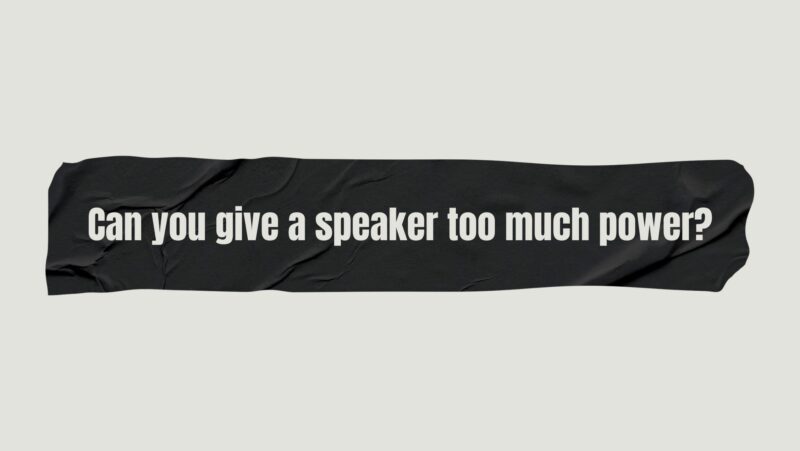The pursuit of audio perfection often leads enthusiasts to explore the boundaries of their equipment’s capabilities. Yet, within this realm of sonic discovery lies a critical question: Can you give a speaker too much power? The temptation to push the limits and unleash a torrent of power onto your speakers is tantalizing, but it comes with a set of potential consequences. This article delves into the intricate relationship between power and speakers, exploring the benefits, risks, and considerations that arise when providing excessive power to these audio marvels.
The Power Surge: Understanding Speaker Power Limits
Before embarking on the journey of overdriving speakers with excessive power, it’s essential to comprehend the concept of power handling. Speaker power handling refers to the maximum amount of electrical power a speaker can receive without distorting the sound or risking damage. This specification is usually denoted in watts and is accompanied by two crucial values:
- RMS Power Handling: The RMS (Root Mean Square) value represents the continuous power a speaker can handle without distortion over extended periods. It’s a vital indicator of a speaker’s sustained performance.
- Peak Power Handling: The peak power handling signifies the maximum power a speaker can handle in short bursts, typically for milliseconds. This specification reflects the speaker’s ability to endure sudden power spikes.
The Temptation of Excessive Power
Amplifying a speaker with more power than its specified limits can yield both positive and negative outcomes, each of which deserves thorough exploration.
Benefits of Overpowering Speakers
- Increased Volume and Intensity: Providing excessive power can lead to a significant increase in volume and sonic intensity. This can be particularly enticing for audio enthusiasts who crave a more immersive auditory experience.
- Enhanced Low-Frequency Response: Excessive power applied to low-frequency drivers can amplify bass response, delivering a more profound and resonant low-end impact.
- Dynamic Range: Controlled bursts of excessive power can enhance a speaker’s transient response, allowing it to reproduce rapid changes in audio signals with greater accuracy.
Risks of Overpowering Speakers
- Distortion and Clipping: Applying excessive power to a speaker can lead to distortion and clipping. These phenomena occur when the speaker’s components struggle to replicate the audio signal accurately, resulting in compromised sound quality.
- Mechanical Strain: The amplified power causes more pronounced diaphragm movement, potentially straining the suspension system, voice coil, and diaphragm itself. This can result in a loss of precision in sound reproduction.
- Heat Generation: The higher power levels translate into increased electrical energy being converted into mechanical motion. This generates excess heat, which can weaken adhesives, degrade materials, and harm the speaker’s overall integrity.
- Potential Permanent Damage: Continuous overloading can lead to permanent damage of components like the diaphragm, voice coil, and even magnet structures, impacting overall speaker performance.
Striking the Balance: Responsible Power Application
Responsible application of power involves a delicate balance between exploration and preservation. Several considerations play a vital role in navigating this terrain.
- Matching Amplification: Ensuring the amplifier’s power output aligns closely with the speaker’s RMS power handling is essential to prevent distortion and potential damage.
- Headroom: Incorporating a small margin of headroom between amplifier power output and speaker RMS rating can help avoid distortion during dynamic audio peaks.
- Quality of Amplification: The quality of the amplifier significantly influences the audio experience. A high-quality amplifier can provide better control and clarity, even at lower power levels.
- Safe Operating Zone: Refrain from pushing the amplifier to its maximum capacity, as this can introduce distortion and potential harm to the speaker.
- Monitoring Distortion: Keeping a vigilant eye on distortion levels while applying additional power is crucial. If distortion or clipping occurs, reduce the power output immediately.
Conclusion
The journey into overpowering speakers is a pursuit laden with both allure and caution. While excessive power can yield increased volume, enhanced low frequencies, and dynamic range, the risks of distortion, mechanical strain, heat generation, and potential permanent damage loom ever-present. The key to unlocking this intricate balance lies in wielding power judiciously, respecting the delicate mechanics of sound reproduction and the thresholds of speaker components.
As audio enthusiasts embark on this auditory odyssey, they must remember that power is a double-edged sword. The benefits of immersion and intensity must be weighed against the potential pitfalls of compromised sound quality and lasting damage. By understanding the specifications, recognizing the risks, and prioritizing responsible application, audio aficionados can navigate the journey of overpowering speakers with both exhilaration and reverence, ultimately striking a harmonious chord between power and preservation.


